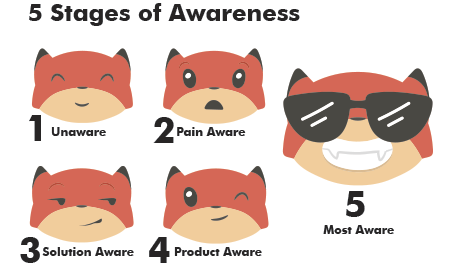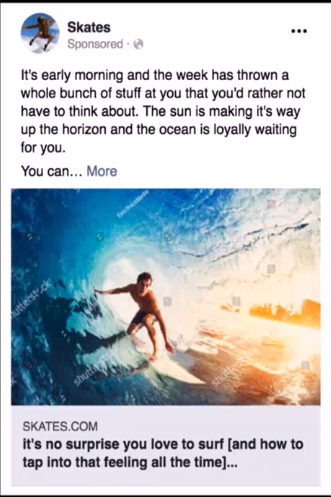
Good copywriters know that the most important part of every piece of copy is the headline and the so-called lead or in simpler terms – opening.
The rest of your copy could be a copywriting masterpiece but if you screw up the beginning you can be sure that no one will bother to read the rest.
This is exactly where the concept of “Awareness Stages” comes to the rescue and it’s possibly the single most important rule in copywriting (it originally comes from the legendary book titled Breakthrough Advertising by Eugene Schwartz)
Now, as much as this concept doesn’t seem to be eCommerce related, it actually is.
The only difference for an average ecommerce store I can think of is probably how deep you tap into core pain points and tie your product into the concept of “transformation” —one of the biggest ideas of marketing as a whole.
In some cases promising a big transformation to someone who just bought a set of kitchen knives may feel a bit contrived but it doesn’t mean you cannot play that card and paint pictures of how your product(s) would improve someone’s life.
Now, back to the main topic. There are five marketing awareness stages and they range between your prospect being completely unaware that they even have a problem and a raving fan of the brand that needs no persuasion (example: hardcore fans of Apple).
In this article I will only focus on stage one (on the right, if we look at it from the most unaware to most aware), which is “Completely Unaware”. This is the “coldest” target audience of all because they’re oblivious to the fact that they even have a problem.
That of course means, they’re the hardest group to market to. The good news is that they’re potentially your new, uncharted markets and a source of ideas for new products.
So when it comes to speaking to these folks, plugging your specific product, a general solution or even talking about some problem from the first line of your copy simply won’t work.
Why?
Because when you don’t know that you have a problem, you will skip past anything that talks about solving this problem, let alone a product or a specific brand.
This can be true of for example, YouTube ads or prospecting campaigns on Facebook where one works with cold audiences. So how do you market to people in this group?
You’ll have to get a bit more creative and find a way to hook your prospects in without bringing up any details of what you do and what you’re offering. Bear in mind that I am only talking about the beginning of your copy. The goal here is to deliver your sales message LATER in the copy without raising their firewall.
This is also a perfect opportunity to brush upon your storytelling skills. You can create a story-driven ad that pulls in readers/watchers with intrigue and builds sufficient interest to later (often in the following step of a sales funnel) introduce your offer or a lead magnet.
A story done well allows prospects to ride the wave of curiosity and find out more.
A story also leaves a more lasting impression on those who engaged with it.
But it’s “all talk no walk” without a proper example, right? Well, here it is:
“Dear Reader, on a beautiful late spring afternoon, twenty-five years ago, two young men graduated from the same college…”
What you just read is probably the most famous “story lead” written by a copywriter from The Wall Street Journal. Since its publication, it’s been successfully copied countless times which proves how effective leveraging a good story is (click here to read the full version.)
Another, more up-to-date example is a Facebook ad by Smart Music Business.
In this ad, the headline is used for qualifying the right audience and sifting out curiosity clickers who diminish the relevance score for the Facebook algorithm and drive your costs up. Then the headline is followed by a story.
Another one:

As you can see, it starts with a story so it’s very neutral and doesn’t set off the “marketing firewall”.
So…..we’ve arrived at the end of the first part of the “Stages of Awareness” series where each week I’ll explain how to use this underlying marketing concept in order to write better copy and therefore attract new customers, lower your customer acquisition cost and sell more stuff.
Excited or excited?
Stay tuned.
Now, here’s the next step you might consider…
If you’ve got a feeling that you’re leaving money on the table because people skip past your emails/ads and you want an extra set of trained, brown and charming eyeballs to look at your stuff—I might be the guy you want to schedule for a free copy-audit.
You can book it here: https://calendly.com/oscarolczakcopywriting/30min
Alternatively , you can also share this article with someone you think could benefit from reading it or leave a comment below. Because why not.